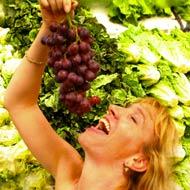The art of reading restaurant wine lists
© by Taylor Eason
 I judge wine lists harshly. Most of the time there are too many Chardonnays, not enough Rieslings, few stellar inexpensive wines by the glass, no descriptions, and not much passion in the selections. No list is perfect, but getting around the fluff is an art.
I judge wine lists harshly. Most of the time there are too many Chardonnays, not enough Rieslings, few stellar inexpensive wines by the glass, no descriptions, and not much passion in the selections. No list is perfect, but getting around the fluff is an art.
1) Beware the "house wine." Often, this is fancy-named, bland "jug" wine making a scandalous profit for the restaurant. To avoid the trap, get the goods: if the house wine equals generic "Chardonnay," ask what brand and assess from there.
2) Buy smart. When the whole table wants wine, consider the value of a bottle instead of several individual glasses. Finding a wine that complements each entree may be daunting, but if you can't, who cares? Drink what you like - happiness will follow.
3) Assess the organization. Is the list organized by region? By variety? By weight? "Weighted" lists are also called "progressive," meaning the wines are ranked from lightest to heaviest in flavor. A good comparison is milk: skim is light, 2 percent is medium, and 4 percent is heaviest. Think of how each type of milk feels in your mouth and you'll understand what "weight" means with wine. Weighted lists normally feature descriptions as well, so their usefulness is tenfold. Listing only the wine names begs the question: "How the hell do I know what that wine tastes like?" (Read my post on what makes a good wine bar)
4) Region-based wine lists are the most difficult to navigate, because they require knowledge of what grape grows where. This is especially annoying when restaurants list "Bordeaux" or "Burgundy" - most people don't know these are Merlot/Cabernet blends and Pinot Noirs or Chardonnays, respectively; but if these wines were listed under the weighted system, consumers could make more informed decisions. Same for varietal organization, although people are becoming more educated about different grapes' tastes and styles.
5) Don't shy away from the lowest-priced offerings. There's a psychology associated with listing the cheaper wines first. The restaurateur expects you won't order the least expensive for fear of looking cheap, and counts on your choice of the third or fourth selection. It's a game ... don't engage. The wine is normally already marked up 300 percent, so if you like the cheapest wine, then do some reverse psychology and save the bucks. (Related article: Top five pet peeves about restaurant wine service)
6) When flustered, seek help. If your server is a clueless plate carrier, ask the manager or owner for advice. More than likely, these enthusiastic individuals see the value in helping you. Don't be shy about asking questions like "I'm having chicken parmigiana, what should I drink with that?" or "My price range is $30 to $40, what can you recommend in a Chardonnay?" (On a date? Point at a selection and ask "How about something in this price range?") or "I'm not a fan of Cabernet, but I like a big wine, is there something on the wine list like that?"
7) If there's no help in sight, or if the atmosphere is so intimidating/stressful your palms start to sweat, go for equal weight with your food. If the food is light in flavor, then choose a light-bodied wine (for instance, Sauvignon Blanc with fish), and the opposite for heavier dishes (heavier syrah/shiraz with spicy red meat). Keep in mind that sparkling wine goes with practically everything. And if there's no brand you recognize, just order a grape type that you normally enjoy and explore.
Aug. 23, 2010
Visit Taylor Eason's Website, and view her growing collection of articles on Taylor Eason's home page on WineLoversPage.com.




